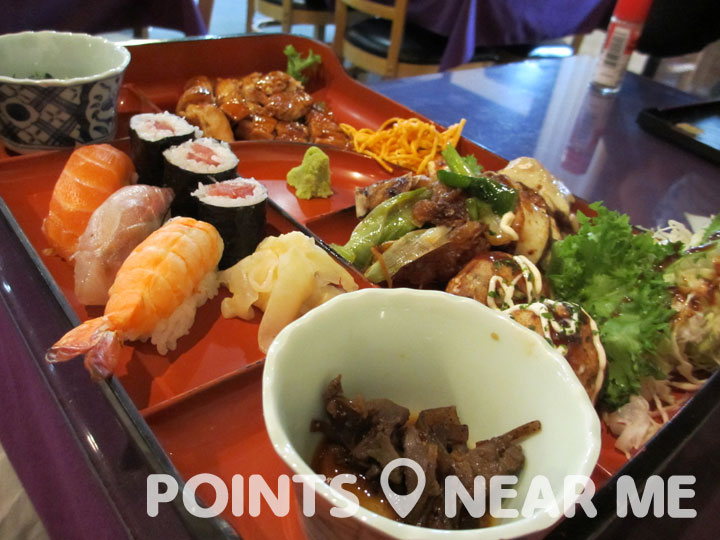Japanese Food Near Me
For centuries, Japanese food has been a staple in the diets of individuals seeking a healthful, balanced. and a spiritual approach to the eating of food. Not every culture approaches food in such an artful and thoughtful manner, but Japanese culture relies on preparation and the relevance of each individual season.
Are you interested in finding Japanese food near you? Simply browse Japanese food near me on the map below and find a list of Japanese restaurants located in close proximity to your current location. Need a bit more information on Japanese food? Who doesn’t? Read on for interesting facts, trivia, and information that will surely impress all of your friends.
Japanese Food Near Me – Find it on the Map
Japanese Food Near Me – Japanese Food Trivia
When did Japanese food truly first emerge?
It’s easy to believe that the Japanese food we all know and love today was just a staple in Japanese diets right from the beginning, but like most food cultures, Japan’s evolution of food was continuous and had many influences. As you search Japanese food near me, consider the unique history behind this cuisine. Japanese food elements that are still prominent today first emerged following the Joman period. This is when Japanese society made a great shift from a semi-sedentary hunter-gatherer lifestyle to a fully agricultural society. With this new found emphasis on farming and growing, rice cultivation began, having first been introduced to the Japanese by China. At this time, rice was commonly prepared through the boiling process and was known as gohan or meshi. Cooked rice was a preferred staple of most Japanese meals. Peasants from the mountainous regions where rice did not grow easily often mixed millet with rice to extend their supplies. During the Kofun period of history, Chinese culture was introduced into Japan from Korea. Because of this, Buddhism became highly influential on Japanese culture. After the 6th century, Japan directly attempted to imitate the Chinese culture of the Tang dynasty. It was this influence that marked the taboos placed on the consumption of meat in Japan. In 675 AD, Emperor Tenmu decreed that the consumption of cattle, horses, dogs, monkeys and chickens was strictly prohibited during the 4th through 9th months of the year. To break the law meant of a death sentence. While many meats are still not prevalent in Japanese cooking, the rules are far more lax and almost non-existent.

Japanese food is always prepared in a thoughtful and artful manner.
True or false: Rice and noodles are a staple in the Japanese diet.
While searching Japanese food near me, you’ll come across a lot of information on traditional foods found in the Japanese diet. One such bit of information is that rice noodles are a staple in almost every Japanese diet. True or not true? This is in fact true. Rice and noodles are the two primary staples of the Japanese diet. Rice, which is either boiled or steamed is served at just about every Japanese meal. Noodles can take on many forms, the most popular of which are soba, thin brown noodles made from buckwheat and udon, thick white noodles made from wheat flour. Ramen, thin curly noodles made from wheat flour are another highly popular noodle type in Japan.
Japanese Food Near Me – Japanese Food Facts
An Eye On The Seasons
One of the many things you learn about Japanese food as you search Japanese food near me is that few cultures place as much emphasis on preparation and artful presentation as the Japanese do. Eating at a proper Japanese restaurant not only feels special it can at times feel almost spiritual and bring great balance into the life. Japanese food is arguably as much about the preparation and the artful presentation as it is about the food itself (though the food is always delicious as well). Every item that is served is prepared with a great deal of thought and artistry. While most American diners only focus on the four annual seasons of the year, Japanese chefs believe that there actually dozens of seasons, all of which boast unique ingredients and flavors that best represent their place in time. If you are to visit Japan in early spring or eat at a restaurant in early spring, every meal that you try will often boast some bitter components. That’s because bitter flavors are seen as a traditional component of this season. Different seasons will bring different flavors. Courses typically include a few small items rather than heaping portions. These courses are fresh and bost simple flavors. Japanese chefs work with top quality ingredients to do as little to change the food as possible all while bringing out the color and flavor.
Infrequent Use of Flavorings
In the US, foods are often bursting with flavors such as garlic, onion, butter, salt and pepper, but in Japan these additives are viewed in an entirely different light. After searching Japanese food near me and finding the proper dining establishment, you’ll quickly realize that the Japanese rarely use flavorings such as garlic, chile peppers, or oil. Instead, most foods are seared, boiled, or eaten raw. Most foods are minimally seasoned to retain authentic taste and physical properties. Umami, which is considered to boast a rich flavor profile in Japanese food, is enhanced with ingredients such as miso, soy sauce, mushrooms, seaweed, bonito flakes, and broth. When food is fried, the batter is thin and watery, this means that the foods will absorb very little oil.












